By Leen Randell
Updated: Jul 04, 2024
10 Best Herbal Decoctions For Eye Swelling
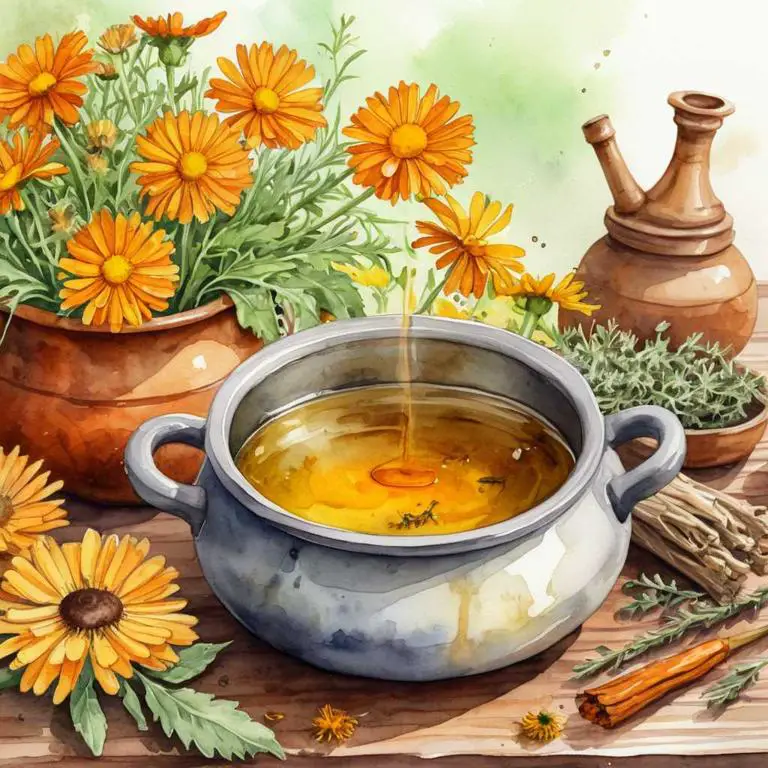
Herbal decoctions for eye swelling are a natural remedy that has been used for centuries to reduce puffiness and discomfort in the eyes.
These decoctions, made by steeping herbs in hot water, help to soothe and calm the delicate skin around the eyes, reducing inflammation and swelling. For example, chamomile and calendula decoctions have anti-inflammatory properties that can ease redness and itching, while peppermint and cucumber decoctions cool and constrict blood vessels to reduce puffiness.
By using these herbal decoctions, individuals can enjoy improved eye health and reduced discomfort, allowing them to feel more refreshed and confident throughout the day.
The following article describes in detail the most important decoctions for eye swelling, including medicinal properties, parts of herbs to use, and recipes for preparations.
- 1. Hamamelis virginiana
- 2. Calendula officinalis
- 3. Echinacea angustifolia
- 4. Ginkgo biloba
- 5. Hypericum perforatum
- 6. Aloe vera
- 7. Arctium lappa
- 8. Equisetum arvense
- 9. Galactites tomentosa
- 10. Gentiana lutea
- What is the best combination of herbal decoctions to use for eye swelling?
- What ailments similar to eye swelling are treated with herbal decoctions?
1. Hamamelis virginiana
American witch hazel decoctions helps with eye swelling because of its potent anti-inflammatory properties.
The tannins present in witch hazel have been shown to reduce inflammation and ease puffiness, making it an effective natural remedy for soothing irritated eyes.
By applying a cooled compress of the decoction to the affected area, the warmth from the herb helps to constrict blood vessels and reduce swelling, providing rapid relief from eye strain and discomfort.
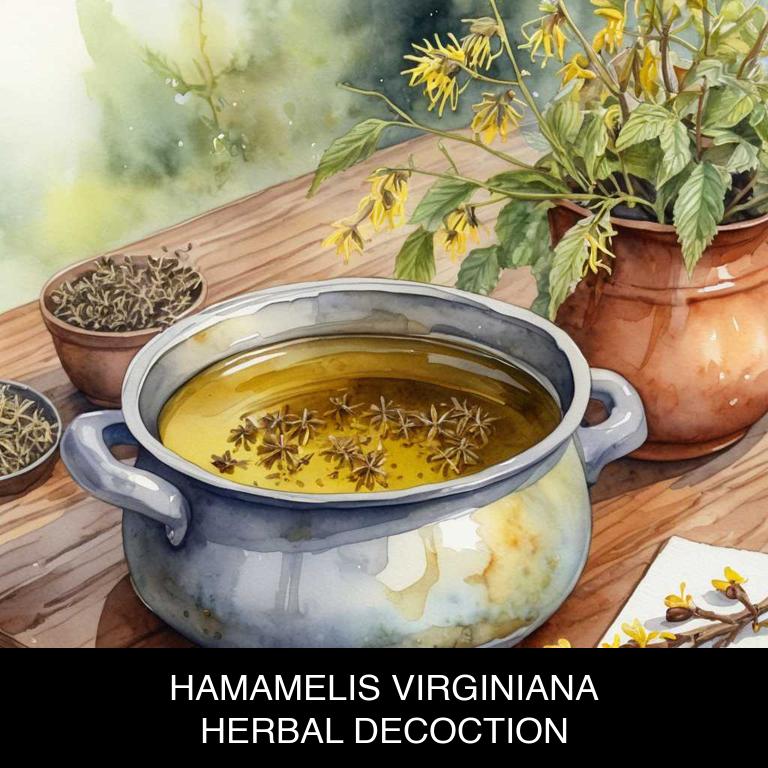
Medicinal Constituents
The list below shows the primary medicinal constituents in Hamamelis virginiana decoctions that help with eye swelling.
- Hamamelitannin: This tannin is responsible for its anti-inflammatory and astringent properties, which help to reduce swelling and soothe eye irritation.
- Hamamelose: This sugar-like compound has anti-inflammatory properties that help to reduce swelling, pain, and inflammation associated with eye swelling.
- Quercetin: This flavonoid has potent anti-inflammatory and antioxidant properties that help to reduce inflammation and prevent further damage to the eyes, thereby alleviating eye swelling.
Parts Used
The list below shows the primary parts of american witch hazel used to make decoctions for eye swelling.
- Buds: The buds are used due to their high concentration of hamamelitannin, a compound with anti-inflammatory and astringent properties.
- Barks: The barks are used for their rich content of tannins and hamamelitannin, which help to reduce swelling and soothe the eyes.
- Leaves: The leaves are used due to their high tannin content and ability to constrict blood vessels, which helps to reduce eye swelling and inflammation.
Quick Recipe
The following recipe gives a procedure to make a basic american witch hazel for eye swelling.
- Gather dried hamamelis virginiana bark and roots and store them in a cool dry place to preserve their potency.
- Measure out 1 teaspoon of dried hamamelis virginiana bark and 1 teaspoon of dried roots for a standard decoction.
- Combine the measured herbs with 2 cups of water in a saucepan and bring the mixture to a boil.
- Reduce the heat to a simmer and let the decoction steep for 10 to 15 minutes to release the medicinal properties.
- Strain the decoction through a cheesecloth or fine-mesh sieve into a clean container and discard the solids.
2. Calendula officinalis
Pot marigold decoctions helps with eye swelling because of its anti-inflammatory properties, which effectively reduce puffiness and redness.
The decoction's antioxidants also help to soothe and calm the delicate skin around the eyes, reducing irritation and discomfort. Additionally, pot marigold contains flavonoids, which have been shown to strengthen blood vessels and improve circulation, further helping to reduce swelling and dark circles under the eyes.
Overall, pot marigold decoctions provide a natural and effective solution for alleviating eye swelling.

Medicinal Constituents
The list below shows the primary medicinal constituents in Calendula officinalis decoctions that help with eye swelling.
- Triterpenoids: These compounds exhibit anti-inflammatory and antioxidant properties, which help reduce swelling and inflammation in the eyes.
- Flavonoids: Specifically, flavonoids such as quercetin and kaempferol present in Calendula have anti-inflammatory and antioxidant activities, contributing to the reduction of eye swelling.
- Carotenoids: Carotenoids like lutein and zeaxanthin in Calendula have antioxidant properties, which help protect the eyes from oxidative stress and inflammation, subsequently reducing eye swelling.
Parts Used
The list below shows the primary parts of pot marigold used to make decoctions for eye swelling.
- Flowers: The flowers are used due to their anti-inflammatory properties, which help reduce swelling and soothe irritated eyes.
- Leaves: The leaves are utilized for their astringent and anti-inflammatory effects, which aid in reducing eye swelling and promoting healing.
- Stems: The stems of Calendula officinalis are used for their anti-inflammatory and antioxidant properties, which help alleviate eye swelling and promote overall eye health.
Quick Recipe
The following recipe gives a procedure to make a basic pot marigold for eye swelling.
- Gather 1 tablespoon dried calendula officinalis flowers in a clean glass container for storage.
- Combine 1 tablespoon dried calendula officinalis flowers with 1 cup boiling water in a heat-resistant glass cup.
- Steep the mixture for 10 to 15 minutes to allow the herbs to infuse into the water.
- Strain the liquid using a cheesecloth or a fine-mesh sieve into a clean glass container.
- Store the decoction in the refrigerator for up to 2 days or freeze for later use.
3. Echinacea angustifolia
Kansas coneflower decoctions helps with eye swelling because of its unique combination of anti-inflammatory compounds, such as echinaceol and polyphenols.
These natural agents work together to reduce puffiness and soothe irritated eyes. The decoction's antioxidant properties also help protect the delicate tissues around the eyes from oxidative stress and damage, promoting healthy circulation and reducing inflammation.
As a result, herbal Kansas coneflower decoctions provide effective relief for eye swelling, making it a popular natural remedy for sinus pressure and allergies.
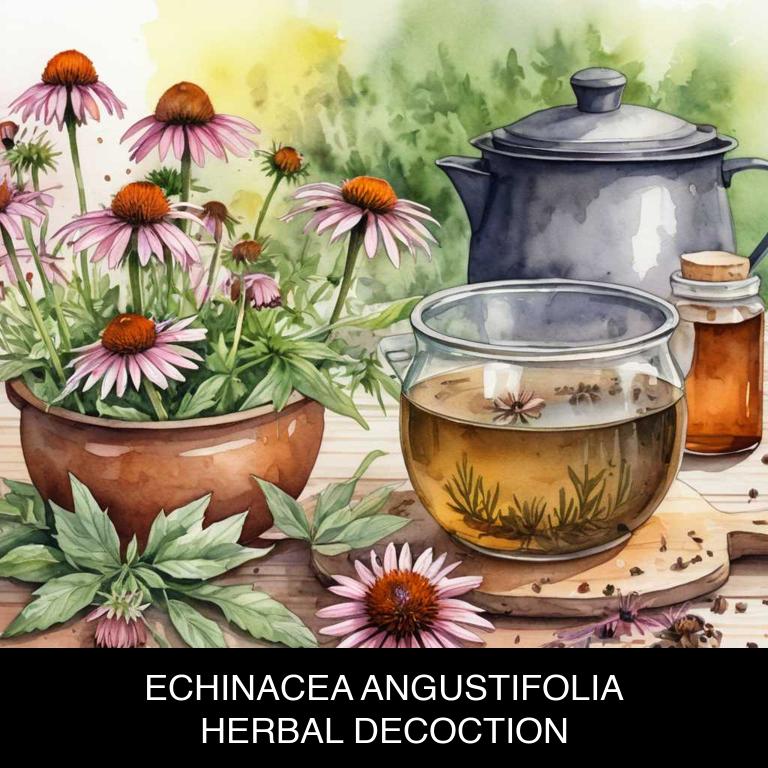
Medicinal Constituents
The list below shows the primary medicinal constituents in Echinacea angustifolia decoctions that help with eye swelling.
- Icariin: Icariin, a flavonoid glycoside, helps reduce eye swelling by inhibiting the production of pro-inflammatory cytokines and mediators.
- Alkylamides: These phenolic compounds, particularly cichoric acid, have anti-inflammatory and antioxidant properties that help alleviate eye swelling by scavenging free radicals and reducing inflammation.
- Cichorin: Cichorin, a sesquiterpene lactone, exhibits anti-inflammatory and immunomodulatory effects that contribute to the reduction of eye swelling by regulating the immune response and preventing the release of pro-inflammatory mediators.
Parts Used
The list below shows the primary parts of kansas coneflower used to make decoctions for eye swelling.
- Roots: The roots contain high concentrations of compounds with anti-inflammatory properties, making them effective in reducing eye swelling.
- Leaves: The leaves have been traditionally used for their medicinal properties, including anti-inflammatory and antioxidant effects, to alleviate eye swelling.
- Barks: The barks of Echinacea angustifolia contain compounds that have been used to reduce inflammation and swelling, including in the eyes.
Quick Recipe
The following recipe gives a procedure to make a basic kansas coneflower for eye swelling.
- Harvest echinacea angustifolia roots and rhizomes in the fall after the first frost to ensure potency.
- Clean and dry the roots and rhizomes thoroughly to prevent contamination and spoilage.
- Chop the dried roots and rhizomes into small pieces to increase surface area and promote extraction.
- Steep one to two teaspoons of chopped root and rhizome mixture in boiling water for 5 to 10 minutes.
- Strain the decoction through a cheesecloth or fine-mesh sieve to remove solids and obtain the liquid extract.
4. Ginkgo biloba
Maidenhair tree decoctions helps with eye swelling because it contains a unique combination of flavonoids, saponins, and essential oils that work together to reduce inflammation and improve circulation in the delicate tissues around the eyes.
The decoction's anti-inflammatory properties help to constrict blood vessels, reducing puffiness and swelling, while its antioxidant effects protect the eyes from oxidative damage caused by free radicals.
This natural remedy is a safe and effective way to soothe and calm irritated or swollen eyes.
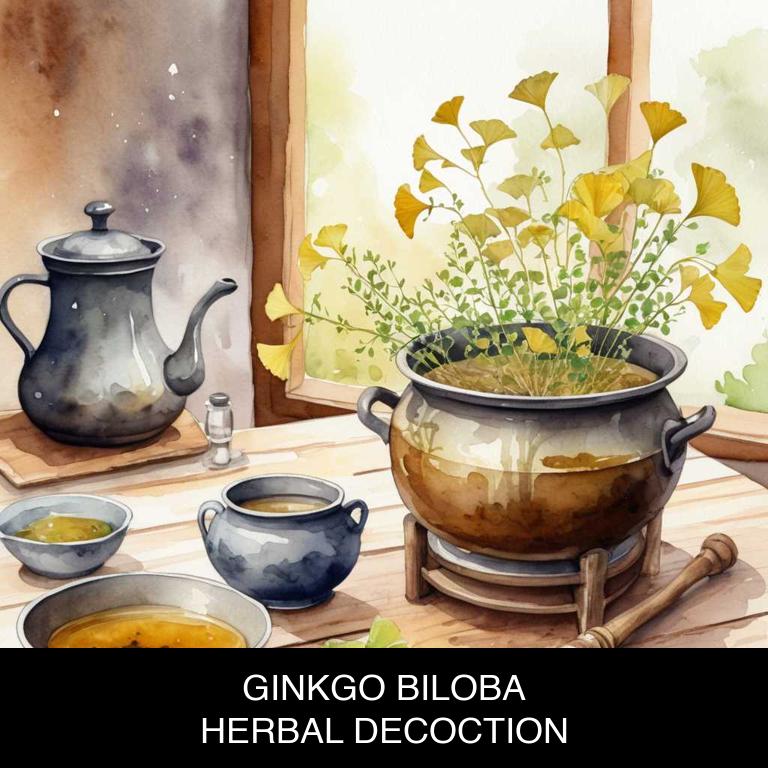
Medicinal Constituents
The list below shows the primary medicinal constituents in Ginkgo biloba decoctions that help with eye swelling.
- Flavonoids: These compounds help reduce eye swelling by exerting anti-inflammatory and antioxidant effects, thereby decreasing the severity of edema and promoting tissue repair.
- Bilobalide: This triterpene lactone has anti-inflammatory properties that help alleviate eye swelling by inhibiting the production of pro-inflammatory mediators and promoting vasodilation, which helps reduce fluid accumulation in the tissues.
- Quercetin: As a potent flavonoid, quercetin exhibits strong anti-inflammatory and antioxidant activities that contribute to the reduction of eye swelling by scavenging free radicals, inhibiting the production of pro-inflammatory enzymes, and promoting vascular health.
Parts Used
The list below shows the primary parts of maidenhair tree used to make decoctions for eye swelling.
- Leaves: Leaves are the most commonly used part due to their high concentration of flavonoids and terpenoids, which are known for their anti-inflammatory properties.
- Seeds: Seeds are used in decoctions due to their high content of bilobalide, a compound that helps to reduce inflammation and swelling in the eyes.
- Barks: Barks are used in decoctions for their anti-inflammatory properties, which help to reduce swelling and pain in the eyes.
Quick Recipe
The following recipe gives a procedure to make a basic maidenhair tree for eye swelling.
- Harvest 50 to 100 grams of dried ginkgo biloba leaves from a trusted source in early fall.
- Rinse the ginkgo biloba leaves in cold water to remove any impurities or debris.
- Combine the ginkgo biloba leaves with 1 liter of boiling water in a large pot.
- Steep the mixture for 10 to 30 minutes to allow the active ingredients to infuse.
- Strain the decoction through a cheesecloth or fine-mesh sieve into a clean container.
5. Hypericum perforatum
St John's wort decoctions helps with eye swelling because of its anti-inflammatory and antioxidant properties.
The herbs contain flavonoids, which have been shown to reduce inflammation and alleviate swelling in the body. When used as an eye wash or applied topically to the affected area, St John's wort can help to soothe and calm irritated eyes, reducing redness and puffiness.
This natural remedy can provide effective relief from eye strain and fatigue, making it a popular choice for promoting healthy and comfortable vision.
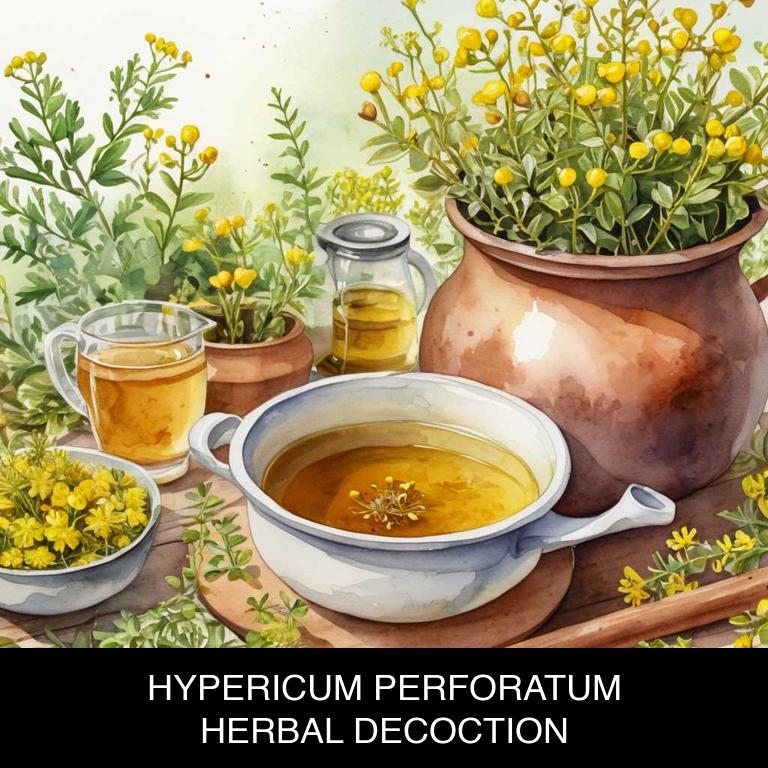
Medicinal Constituents
The list below shows the primary medicinal constituents in Hypericum perforatum decoctions that help with eye swelling.
- Harpagide: It has anti-inflammatory properties, which help reduce swelling and inflammation in the eyes.
- Hyperforin: It has potent anti-inflammatory and antioxidant effects, which help alleviate eye swelling by reducing oxidative stress and inflammation.
- Quercetin: It is a flavonoid that has anti-inflammatory and antioxidant properties, helping to reduce eye swelling by inhibiting the production of pro-inflammatory enzymes and free radicals.
Parts Used
The list below shows the primary parts of st john's wort used to make decoctions for eye swelling.
- Leaves: Rich in flavonoids and other compounds that have anti-inflammatory and antiseptic properties, helping to reduce swelling and soothe eye irritation.
- Flowers: Contain bioflavonoids and anthocyanins, which have antioxidant and anti-inflammatory effects that can help alleviate eye swelling and promote healing.
- Stems: May be used in decoctions for their antiseptic and anti-inflammatory properties, which can help reduce eye swelling and prevent infection.
Quick Recipe
The following recipe gives a procedure to make a basic st john's wort for eye swelling.
- Gather 1-2 grams of dried hypericum perforatum flowers and leaves from a reputable source.
- Boil 250 milliliters of water in a saucepan over high heat for 5 minutes.
- Add the dried hypericum perforatum flowers and leaves to the boiling water.
- Reduce heat to low and simmer for 10-15 minutes or until the liquid has reduced slightly.
- Strain the decoction through a fine-mesh sieve into a clean glass container and discard the solids.
6. Aloe vera
Aloe decoctions helps with eye swelling because of its anti-inflammatory properties, which effectively reduce puffiness and redness.
The soothing gel extracted from aloe vera contains compounds like aloin and aloe-emodin that calm irritated tissues and constrict blood vessels, reducing fluid accumulation around the eyes.
As a result, herbal aloe decoctions can provide quick relief from eye swelling, making them a popular remedy for reducing puffiness and promoting healthy, refreshed-looking eyes.
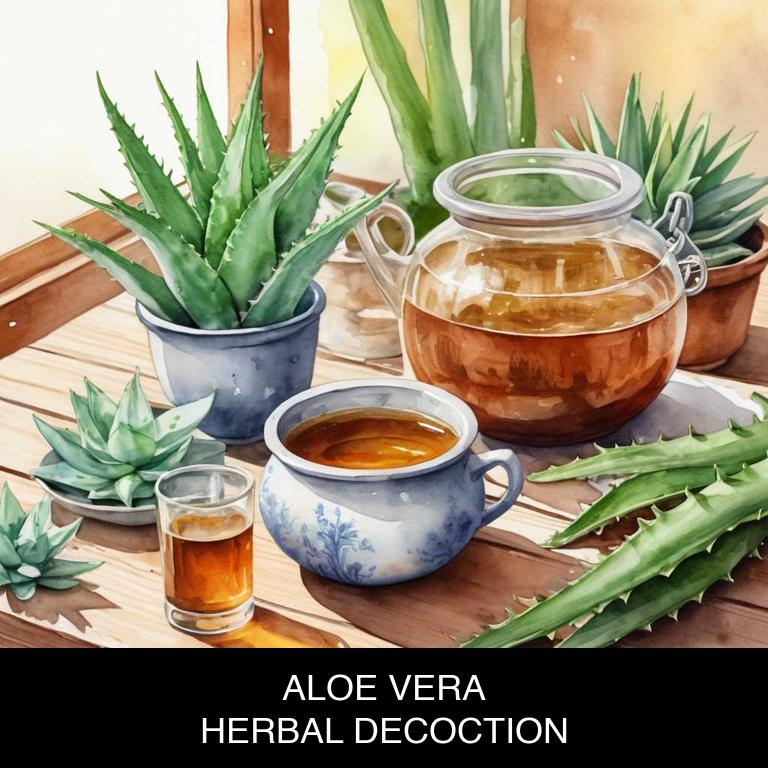
Medicinal Constituents
The list below shows the primary medicinal constituents in Aloe vera decoctions that help with eye swelling.
- Anthraquinones: These compounds, particularly aloe-emodin, have anti-inflammatory properties that help reduce swelling and inflammation in the eyes.
- Flavonoids: Flavonoids like kaempferol and quercetin in Aloe vera have potent antioxidant and anti-inflammatory effects, which help alleviate eye swelling and promote healing.
- Glycoproteins: The glycoproteins present in Aloe vera, such as aloin, have anti-inflammatory and soothing properties that help calm and reduce eye swelling.
Parts Used
The list below shows the primary parts of aloe used to make decoctions for eye swelling.
- Leaves: Most used part due to their high concentration of anti-inflammatory compounds such as aloe-emodin and aloin.
- Rhyzomes: Used for their medicinal properties, including anti-inflammatory and antimicrobial effects, to help reduce swelling and soothe the eyes.
- Barks: Utilized for their aloe-emodin content, which helps to reduce inflammation and alleviate eye swelling.
Quick Recipe
The following recipe gives a procedure to make a basic aloe for eye swelling.
- Harvest aloe vera leaves for decoction by selecting fresh green leaves from mature plants.
- Cut the leaves into small pieces weighing about 2 ounces for every quart of water.
- Combine the aloe vera pieces with 4 cups of water in a saucepan and bring to boil.
- Reduce heat and simmer the mixture for 20-30 minutes or until the liquid has reduced by half.
- Strain the decoction through a cheesecloth or fine-mesh sieve into a clean container.
7. Arctium lappa
Burdock decoctions helps with eye swelling because of its potent anti-inflammatory properties, which effectively reduce puffiness and redness.
The saponins present in burdock root have been shown to inhibit the production of pro-inflammatory chemicals, thereby reducing the swelling and discomfort associated with eye problems such as conjunctivitis or sinus pressure.
Additionally, burdock decoctions may help to soothe and calm irritated eyes, promoting a sense of relaxation and relief from eye strain.
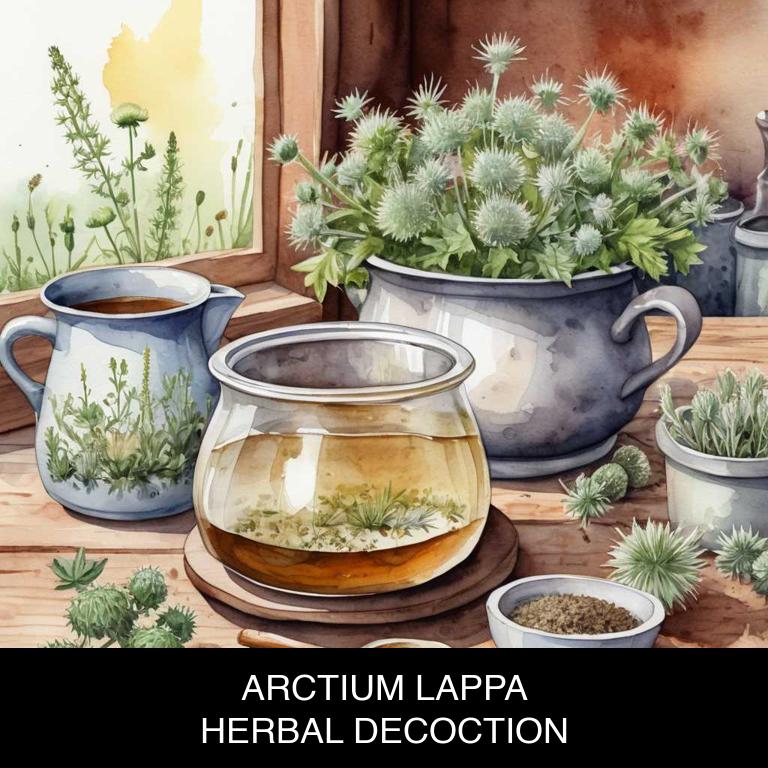
Medicinal Constituents
The list below shows the primary medicinal constituents in Arctium lappa decoctions that help with eye swelling.
- Inulin: A type of fructan, inulin is a polysaccharide that has anti-inflammatory properties, which can help reduce swelling and inflammation associated with eye conditions.
- Arctiin: A phenolic compound, arctiin has been shown to possess anti-inflammatory and antioxidant properties, which can help alleviate eye swelling and promote overall eye health.
- Arctigenin: A lignan, arctigenin has been found to possess anti-inflammatory and antioxidant properties, which can help reduce swelling and inflammation in the eyes, promoting a faster recovery from eye-related issues.
Parts Used
The list below shows the primary parts of burdock used to make decoctions for eye swelling.
- Roots: They are rich in anti-inflammatory compounds that help reduce swelling and ease pain in the eyes.
- Leaves: The leaves contain bioactive compounds that possess anti-inflammatory properties, making them effective in treating eye swelling.
- Seeds: The seeds of Arctium lappa are used to prepare decoctions that help reduce inflammation and alleviate eye discomfort due to their anti-inflammatory and antioxidant properties.
Quick Recipe
The following recipe gives a procedure to make a basic burdock for eye swelling.
- Harvest 20-30 grams of arctium lappa roots from a clean and dry location.
- Clean the roots thoroughly with water to remove any dirt or debris.
- Chop the roots into small pieces and mix with 500 milliliters of cold water.
- Heat the mixture over low heat for 10-15 minutes or until the liquid has reduced by half.
- Strain the decoction through a cheesecloth or a fine-mesh sieve into a clean container.
8. Equisetum arvense
Field horsetail decoctions helps with eye swelling because it contains a unique combination of flavonoids, phenolic acids, and saponins that work together to reduce inflammation and congestion in the eyes.
The antioxidants present in the decoction help to neutralize free radicals, while the anti-inflammatory properties soothe and calm swollen tissues.
Additionally, the diuretic properties of field horsetail help to remove excess fluids and toxins from the body, further reducing swelling and puffiness around the eyes.
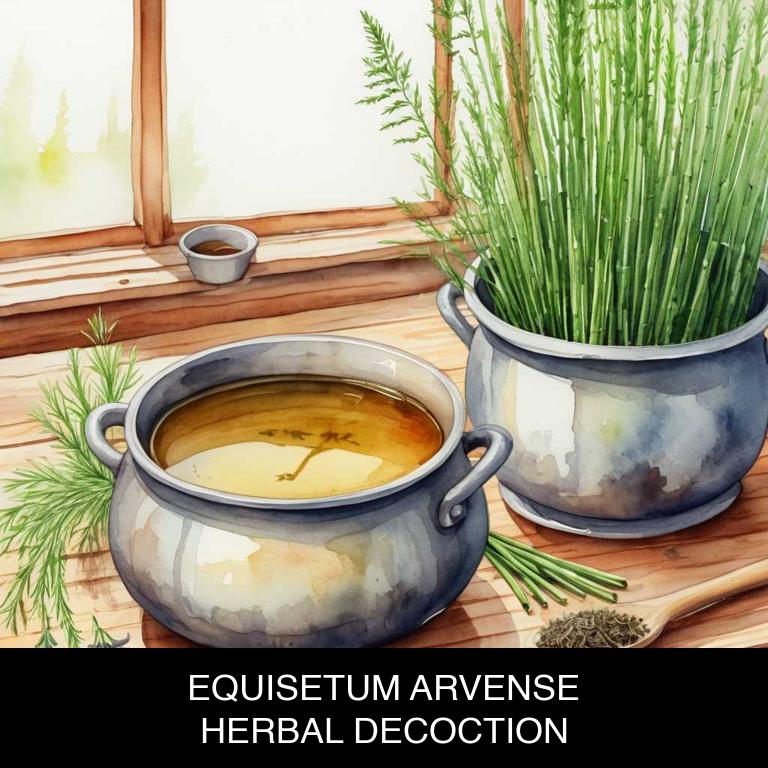
Medicinal Constituents
The list below shows the primary medicinal constituents in Equisetum arvense decoctions that help with eye swelling.
- Sesquiterpenes: These compounds exhibit anti-inflammatory properties, which help to reduce swelling and ease eye discomfort.
- Flavonoids: Equisetum arvense contains flavonoids that have antioxidant and anti-inflammatory effects, which can help to alleviate eye swelling and promote healing.
- Furanosesquiterpenes: These terpenoid compounds have been shown to possess anti-inflammatory and analgesic properties, which can help to reduce eye swelling, pain, and inflammation.
Parts Used
The list below shows the primary parts of field horsetail used to make decoctions for eye swelling.
- Roots: They are used for their anti-inflammatory properties and are often employed in traditional medicine to reduce swelling and pain.
- Stems: The stems are also used for their anti-inflammatory and antiseptic properties, helping to soothe and calm irritated areas around the eyes.
- Leaves: The leaves are used for their cooling effect, which can help to reduce swelling and ease discomfort in the eyes.
Quick Recipe
The following recipe gives a procedure to make a basic field horsetail for eye swelling.
- Harvest 1/4 cup of fresh equisetum arvense roots or 2 tablespoons of dried roots in the spring or fall.
- Wash the harvested roots thoroughly with cold water to remove dirt and debris.
- Chop the cleaned equisetum arvense roots into small pieces and add them to a pot.
- Boil 2 cups of water and add the chopped roots to the pot for 10 to 15 minutes.
- Strain the decoction and discard the solids after the boiling process is complete.
9. Galactites tomentosa
Resin oak decoctions helps with eye swelling because of its anti-inflammatory properties, which effectively reduce puffiness and redness.
The decoction's antioxidant compounds work to soothe and calm irritated tissues, alleviating discomfort and promoting healthy circulation around the eyes. Additionally, the decoction's astringent properties help to constrict blood vessels, reducing swelling and leaving the eyes feeling refreshed and revitalized.
Regular use of resin oak decoctions can provide long-term benefits for eye health and overall well-being.
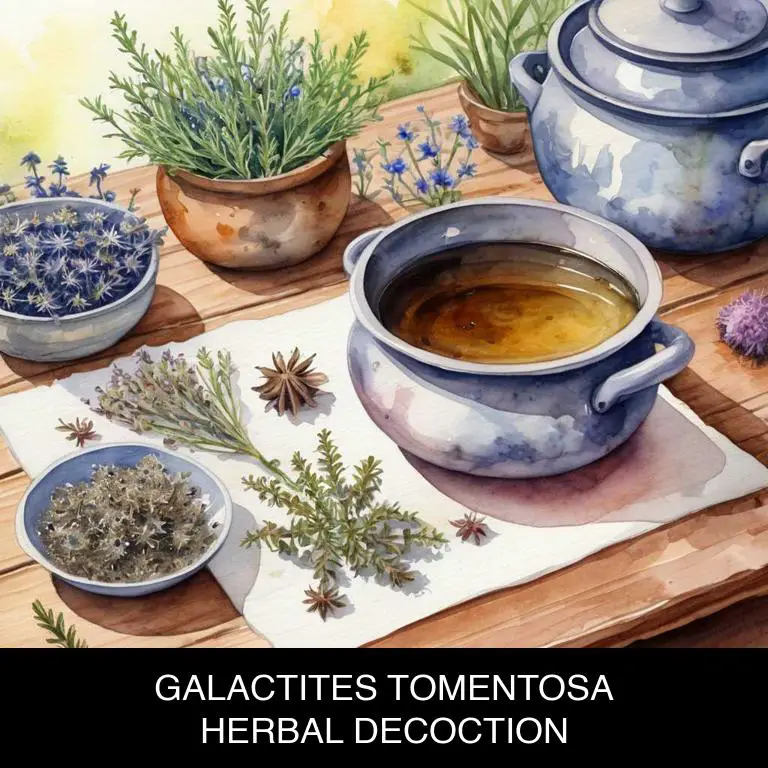
Medicinal Constituents
The list below shows the primary medicinal constituents in Galactites tomentosa decoctions that help with eye swelling.
- Flavonoids: These plant-derived compounds have anti-inflammatory properties, which help reduce swelling and inflammation in the eyes.
- Saponins: These natural glycosides have anti-inflammatory and antioxidant properties, which may help alleviate eye swelling and promote overall eye health.
- Alkaloids: Some alkaloids present in Galactites tomentosa, such as solasodine and solanine, have anti-inflammatory and vasoconstrictive effects, which can help reduce swelling and promote healing in the eyes.
Parts Used
The list below shows the primary parts of resin oak used to make decoctions for eye swelling.
- Roots: The root of Galactites tomentosa is used to make decoctions for eye swelling due to its potential anti-inflammatory properties.
- Leaves: The leaves of Galactites tomentosa are used for decoctions to treat eye swelling due to their possible anti-inflammatory and soothing effects.
- Barks: The bark of Galactites tomentosa is used to make decoctions for eye swelling due to its potential to reduce swelling and inflammation.
Quick Recipe
The following recipe gives a procedure to make a basic resin oak for eye swelling.
- Gather 30-60 grams of galactites tomentosa roots and rinse them with cold water to remove any impurities.
- Chop the galactites tomentosa roots into small pieces to increase their surface area for infusion.
- Combine the chopped galactites tomentosa roots with 1 liter of boiling water in a saucepan to create a decoction.
- Simmer the decoction for 10-15 minutes to extract the active compounds from the galactites tomentosa roots.
- Strain the decoction through a cheesecloth or a fine-mesh sieve to remove the solids and discard the galactites tomentosa roots.
10. Gentiana lutea
Yellow gentian decoctions helps with eye swelling because of its potent anti-inflammatory properties, which effectively reduce puffiness and ease discomfort.
The decoction's active compounds, such as gentiopicroside and amarogentin, have been shown to inhibit the production of pro-inflammatory chemicals in the body.
This means that when used topically or ingested, yellow gentian decoctions can help to constrict blood vessels, reduce fluid accumulation, and promote a healthy circulation around the eyes, ultimately providing relief from swelling and discomfort.
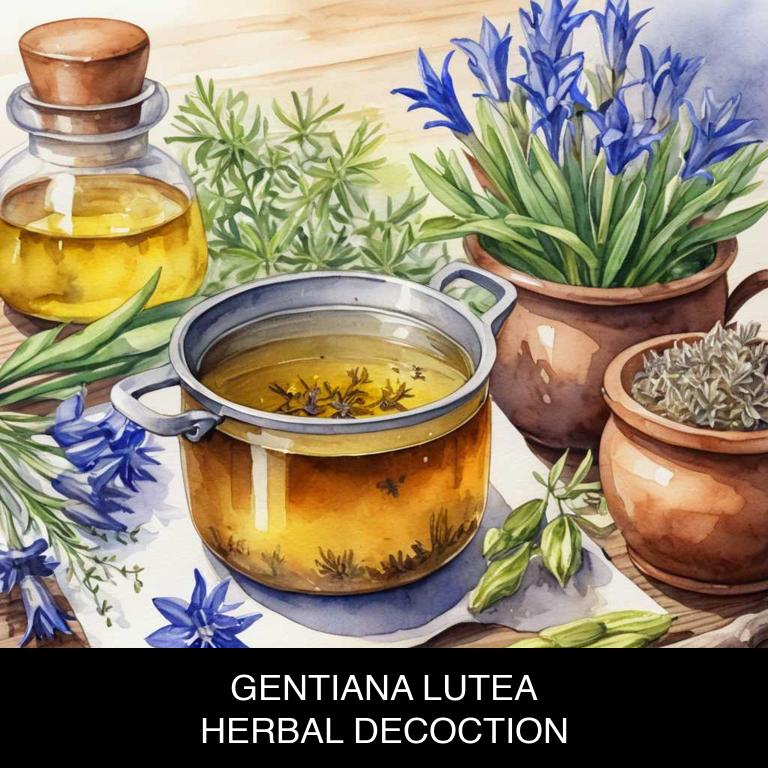
Medicinal Constituents
The list below shows the primary medicinal constituents in Gentiana lutea decoctions that help with eye swelling.
- Amarogentin: Amarogentin is a secoiridoid glycoside that has anti-inflammatory properties, which can help reduce the swelling and inflammation associated with eye conditions.
- Gentiopicrin: Gentiopicrin is a secoiridoid glycoside that has been shown to possess anti-inflammatory and antioxidant effects, which can help alleviate eye swelling and protect the eyes from damage.
- Quercetin: Quercetin is a flavonoid with potent anti-inflammatory and antioxidant properties, which can help reduce eye swelling by inhibiting the production of inflammatory mediators and protecting the eyes from oxidative stress.
Parts Used
The list below shows the primary parts of yellow gentian used to make decoctions for eye swelling.
- Roots: They contain gentiopicrin, which helps reduce inflammation and swelling.
- Stems: They are also a source of gentiopicrin, making them useful for treating eye swelling.
- Leaves: They contribute to the overall anti-inflammatory properties found in Gentiana lutea decoctions.
Quick Recipe
The following recipe gives a procedure to make a basic yellow gentian for eye swelling.
- Harvest fresh or dried roots of gentiana lutea in late summer or early fall season.
- Chop the roots into smaller pieces using a sharp knife for easier boiling.
- Combine 4-8 grams of chopped roots with 1 liter of boiling water in a saucepan.
- Boil the mixture for 5-10 minutes then reduce heat to simmer for 15-30 minutes.
- Strain the decoction through a cheesecloth or fine mesh into a clean container.
What is the best combination of herbal decoctions to use for eye swelling?
The best combination of herbal decoctions that help with eye swelling is a blend of chamomile, peppermint, and eyebright.
Chamomile's anti-inflammatory properties reduce redness and soothe the eyes, while peppermint's cooling effect provides immediate relief from swelling. Eyebright's decongestant properties help to reduce fluid buildup and promote healthy drainage.
When brewed together, these herbs create a powerful and soothing eye tonic that can be applied topically or consumed as a tea to alleviate eye swelling and promote overall eye health.
What ailments similar to eye swelling are treated with herbal decoctions?
Ailments similar to eye swelling that are treated with herbal decoctions are various skin issues such as eczema, acne, and psoriasis.
Herbal remedies like aloe vera, turmeric, and neem are commonly used in decoction form to reduce inflammation, soothe irritation, and promote healing. Additionally, conditions like fever blisters, cold sores, and mouth ulcers can also be treated with herbal decoctions containing ingredients like calendula, chamomile, and peppermint.
These natural remedies provide effective relief from discomfort and promote overall well-being.